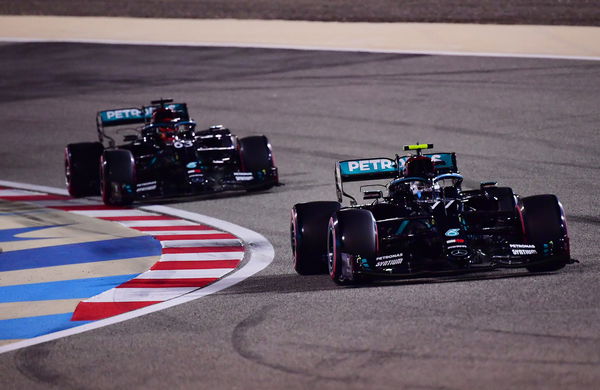
via Reuters
Formula One F1 – Sakhir Grand Prix – Bahrain International Circuit, Sakhir, Bahrain – Mercedes’ Valtteri Bottas and George Russell in action during qualifying Pool via REUTERS/Giuseppe Cacace

via Reuters
Formula One F1 – Sakhir Grand Prix – Bahrain International Circuit, Sakhir, Bahrain – Mercedes’ Valtteri Bottas and George Russell in action during qualifying Pool via REUTERS/Giuseppe Cacace
F1 is thrilling to watch because of the competition that exists among top tier drivers. Safe to say, this adrenaline rush to be at the top has often affected the mentality of drivers from the same team. It is quite visible, especially when the gap between the two racers is not too wide. They often fight for the top spot.
F1 teams currently have to employ exactly two drivers per race. But in the initial years of F1, the early 1950s to 1960s, there was no restriction on the number of cars that a team could pitch in for a race.
ADVERTISEMENT
Article continues below this ad
Era of two-car teams
From 1963 to 1984, regulations allowed teams to enter two drivers per race with one on reserve for any emergency. Since 1985, the FIA required each team to pitch exactly two cars per race.
This was done to ensure that low budget single-car teams cannot enter the race because, with such teams, there are irregularity issues that the point-scoring mechanism cannot handle. Pitching in a single-car is also against the regulations, allowed in exceptional circumstances, say, in case of a driver injury.

via Reuters
Formula One F1 – Bahrain Grand Prix – Bahrain International Circuit, Sakhir, Bahrain – Mercedes’ Lewis Hamilton in action as the race restarts Pool via REUTERS/Tolga Bozoglu
The upper strata teams heavily influence the FIA with money and power, enforcing rules that favor their goals.
Having three cars on the track might not have any significant effect on point accumulation. Hence, it is doubtful that the FIA will allow three cars to run per team in the near future. Further, the technical authority of F1, Pat Symonds, affirmed on considering it to be a probability in further conferences.
Symonds remarked, “It hasn’t been on the agenda,” further continued, “[But] it’s a good point and probably at our next meeting it’s something we will debate.”
Pause to the three-car plan in F1
A three-car per team allowance can cause complications that might jeopardize the sport’s professional nature. Racing customer cars were prevalent in the inception days of F1, and it was a catastrophe when it came to professionalism. Taking a risk with three cars per team would be highly unwise.
However, a three-car team would mean more opportunity for young and inexperienced drivers. They can keep the third car on reserve with a ready-to-deploy junior.
ADVERTISEMENT
Article continues below this ad
If a dominant team were to put up three drivers for a race, it could be a very competitive affair. The drivers will be in the match to an equal level, and it will be a pleasure to watch the best driver take the higher spot on the table.
Extra car equals extra overhead costs – logistics, manufacturing, and paying higher salaries to crew members. This would turn out to be an immense burden for smaller teams with significantly lower budgets than major constructors like Mercedes, Ferarri, and Red Bull. The lower-tier teams might lose all of their competitive edge in the process.
Further, it is a fact known that there are dominant teams in the F1 racing realm. Hence, having three cars in a single team would reduce competitiveness, the challenges, and the adventure.
ADVERTISEMENT
Article continues below this ad
Subsequently, it will make the race monotonous and curb the interest of everyone, which will affect the fanbase and audience count. To lead the race with perfection and super hype, conversely, it is better to have teammates maximum of up to two. However, to become a platform for fresh talents, the number of teams can multiply in number.
Read More – Why did Ferrari Sign Carlos Sainz?
ADVERTISEMENT
ADVERTISEMENT
ADVERTISEMENT
ADVERTISEMENT

